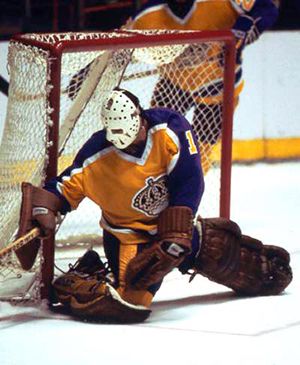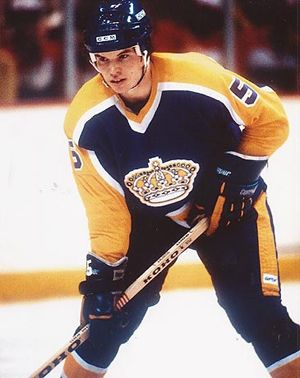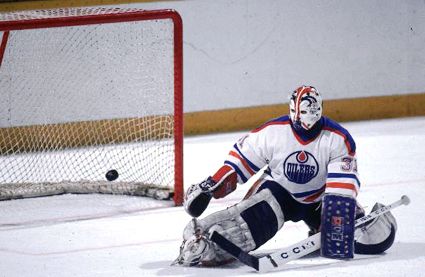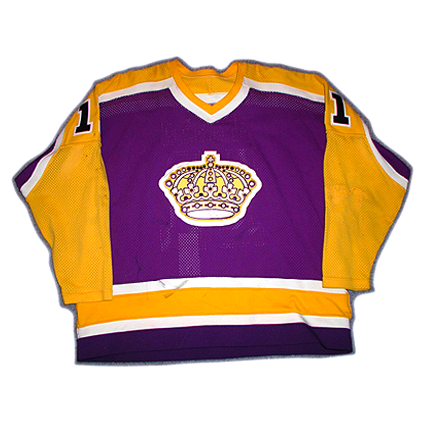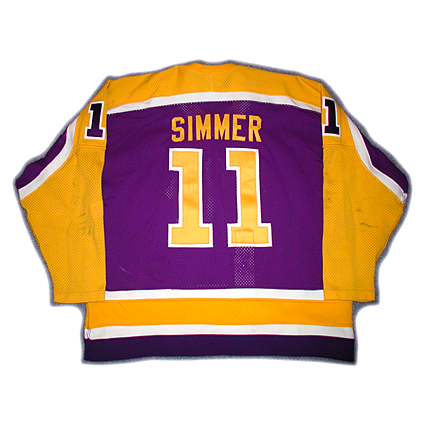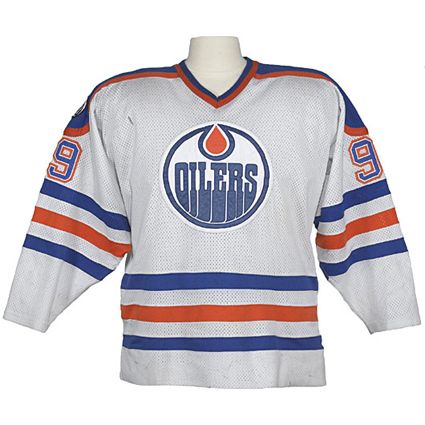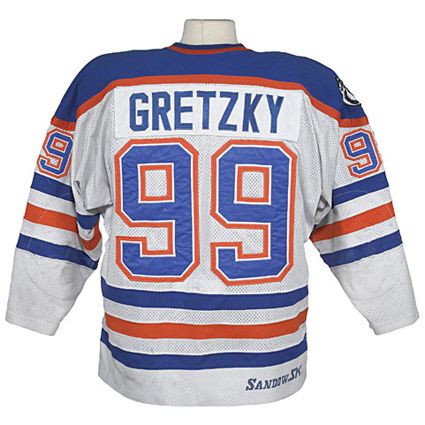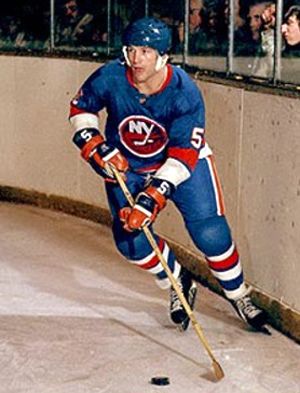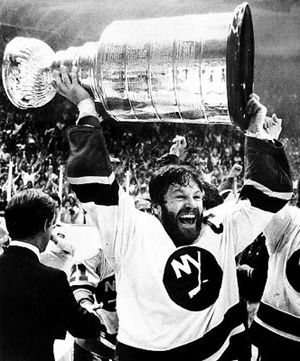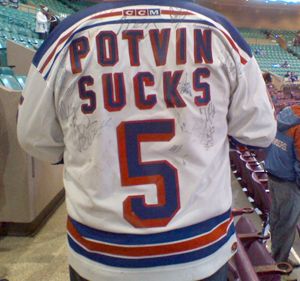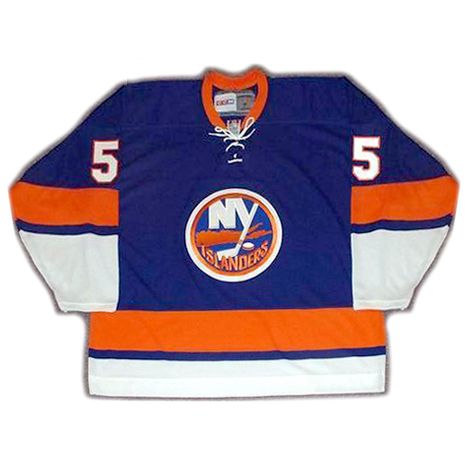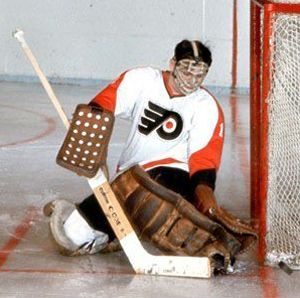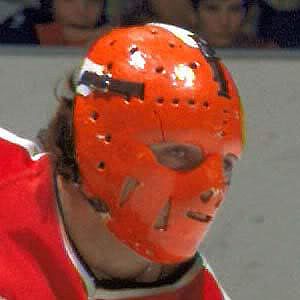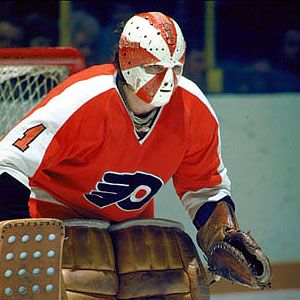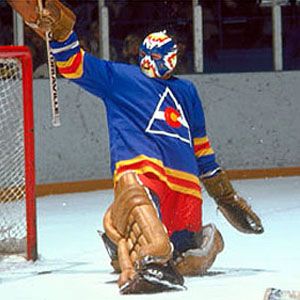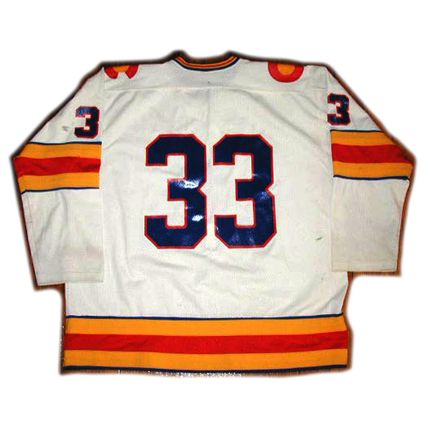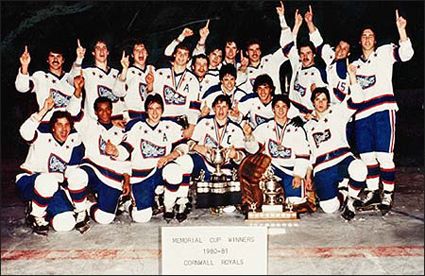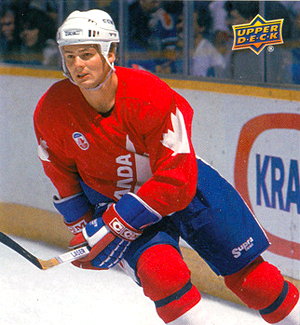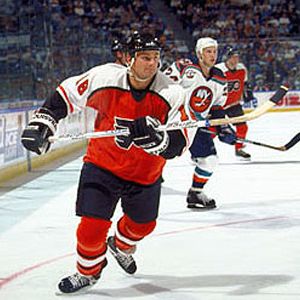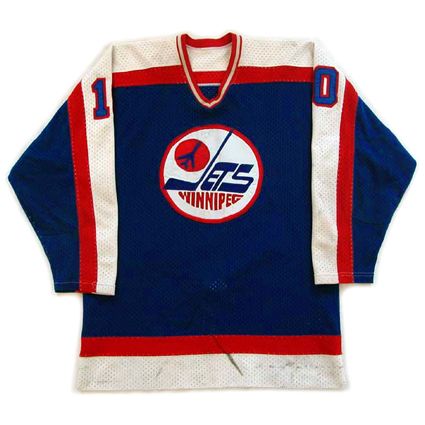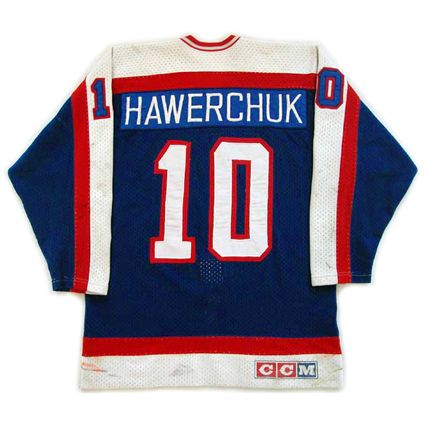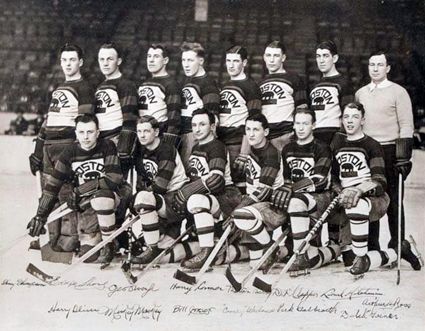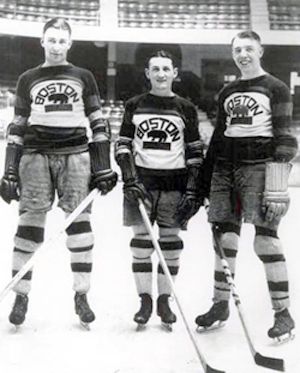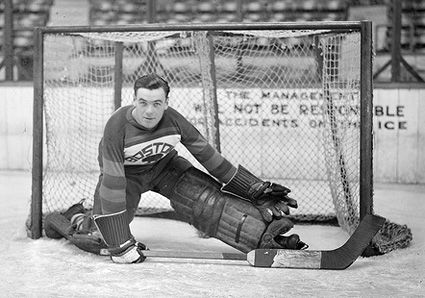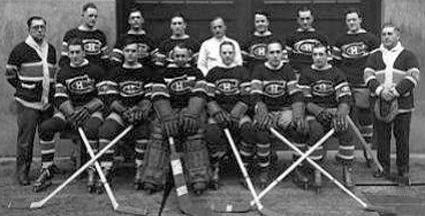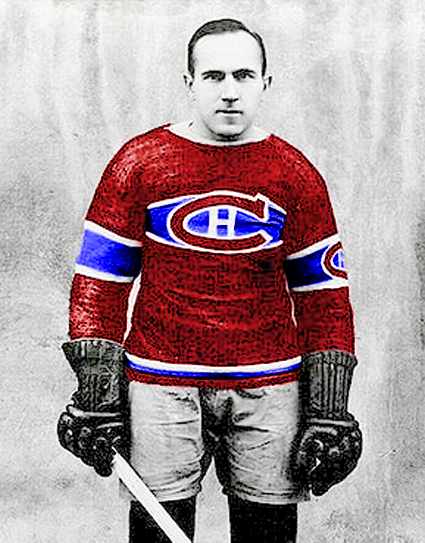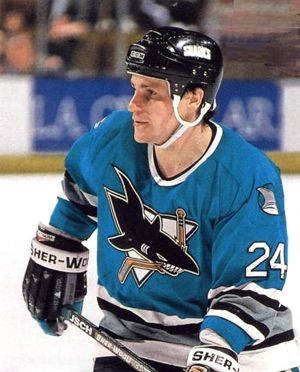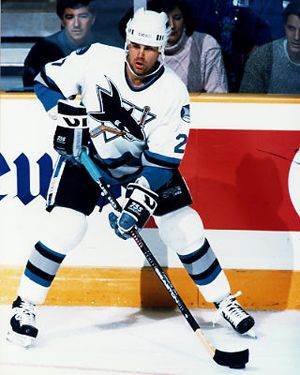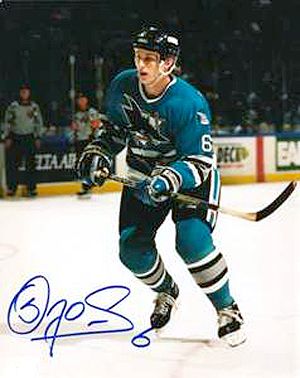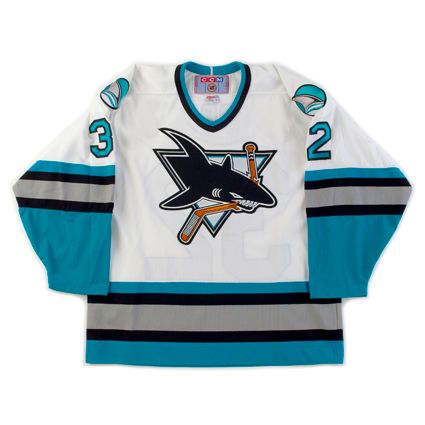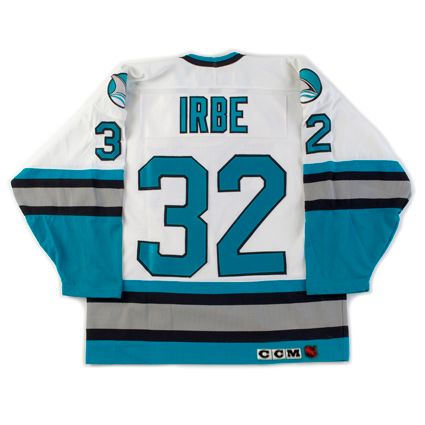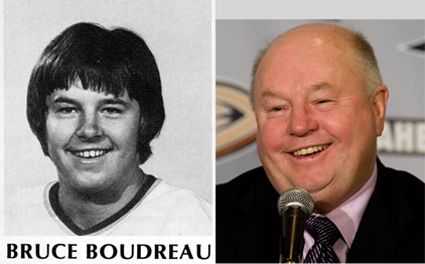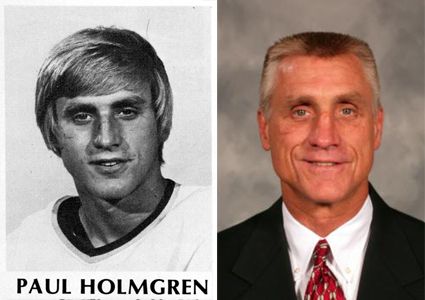Saturday, April 7, 2012
Third String Goalie on Marek vs. Wyshinski
Friday we were lucky enough to be chosen at random as the contestant for "Game Show Friday" on Marek vs. Wyshinski, hosted by Jeff Marek of Sporstnet in Canada and Greg Wyshinski, editor of the Puck Daddy blog on Yahoo!
We were hoping that Marek would be the one coming up with history related questions to challenge us, as we are much more comfortable with questions about hockey's history than Wyshinski's slant toward current events in the NHL.
The theme of the quiz, as stated on the blog, was "Pat LaFontaine", so we felt fairly comfortable going in, having written about LaFontaine more than once here at Third String Goalie. Unfortunately, they threw us a big curveball and, on a takeoff of the great Rick Jeanneret's "La-la-la-la-LaFontaine!" goal call, the quiz was instead themed around players whose last names began with the letters "LA".
Oh boy.
Now we were nervous, fearing either having no idea what the answers would be or drawing a blank on answers we actually knew - both of which would then happen!
Fortunately for us, there was no major cash prize on the line, creating an atmosphere of fun around the quiz, plus we had an ally in Marek, a fellow member of the Society for International Hockey Research, who fed us more than a couple of clues when needed. Why couldn't it have been questions about the relocation of World Hockey Association franchises in the mid-70's or questions about the Pacific Coast Hockey League franchises from 1912-1924? Now that minutiae we know! (No wonder Wyshinski made fun of Marek and I)
We slogged through the quiz as best would could, knowing a few answers on our own and having Marek jog our memory enough times to be declared a "winner", no matter how dubious, but the highlight for us was making them laugh a few times and the enthusiastic endorsement they gave Third String Goalie, including Wyshinski linking to us later on in the day on Puck Daddy, which was very much appreciated and resulted in double our usual amount of traffic for the day.
To listen to our appearance on Game Show Friday, click on the audio player below.
Thanks again to Jeff and Greg for the fun time, the help with the answers and the nice comments about Third String Goalie plus the link to us on Puck Daddy!
If this is your first visit to the blog today, be sure to read today's main entry below about the record setting 1982 playoff game between the Kings and Oilers.
Labels:
Marek vs Wyshynski,
Puck Daddy,
Third String Goalie
1981-82 Los Angeles Kings Charlie Simmer Jersey
The 1981-82 NHL playoffs saw a change to a new format, with the top four teams in each division qualifying for the postseason. The division winner would meet the fourth place club, while the second place finisher would meet the third in a pair of best-of-five series in the opening round.
Bonus jersey: Today's bonus jersey is a 1981-82 Edmonton Oilers Wayne Gretzky jersey as worn during the record setting 18 goal game between the Kings and Oilers on this date in 1982 by the man who led the NHL in scoring during the regular season as he set a new single season scoring record on his way to becoming the first and only player to ever score 200 points in a season with 212.
Gretzky finished the record setting playoff game with a goal and three assists.
This jersey can be identified as bing from the 1981-82 season by the International Year of Disabled Persons patch worn on the upper right sleeve.
In the Smythe Division, the Edmonton Oilers cruised to a first place finish with a 48-17-15 record for 111 points (second overall in the league) and miles ahead of the Vancouver Canucks 77 points, as they trailed the Oilers by 18 wins. The Oilers opponents for the first round of the playoffs were the Los Angeles Kings, who limped into the postseason with a poor 24-41-15 record, earning 63 points in the standings but given a free pass into the playoffs thanks to being in a five team division that included the moribund Colorado Rockies, the worst team in the league, who the Kings cleared by 14 points. The Kings 63 points were actually less than the Washington Capitals 65 points, who missed the playoffs by virtue of finishing last in the rugged Patrick Division which was inhabited by the President's Trophy winning New York Islanders, who finished with 118 points, the New York Rangers (92 points), Philadelphia Flyers (87) and Pittsburgh Penguins (75).
The playoffs got underway on this date in 1982 with all eight series taking to the ice, which included the Oilers hosting the Kings in Edmonton.
Grant Fuhr got the start in goal for the home team, while Mario Lessard got the nod for the visitors from Los Angeles.
The Kings Mario Lessard
Glenn Anderson set the tone for the game early with a goal for the Oilers at the 1:35 mark from Kevin Lowe and Jari Kurri.
After the Kings' Jay Wells was ejected from the game following an altercation with Kurri and trying to get to Lee Fogolin, Steve Bozak answered for the Kings from Jim Fox and Daryl Evans on the power play at exactly 6:00 Dave Semenko in the penalty box for Edmonton.
The high scoring Oilers responded quickly, with Tom Roulston scoring from Pat Hughes 16 second later, followed quickly by Risto Siltanen adding to the Oilers lead just 20 second later from Anderson and Wayne Gretzky.
The NHL's leading scorer in 1982, Wayne Gretzky
Siltanen made it 4-1 for Edmonton before the halfway mark of the first period when he scored his second goal in less than 2 1/2 minutes from Gretzky and Kurri on a power play with the Kings Dave Taylor off the ice.
The Kings let it be known they were not going to go away easily though, as Fox scored at 14:09 from Dave Lewis followed by Taylor scoring on the power play from Charlie Simmer on a power play with just 7 seconds remaining in the period with Gretzky in the box. The first period then came to a close with the Oilers leading 4-3 on the scoreboard and 17-11 in shots on goal.
Doug Smith evened the score at 4-4 with an unassisted goal for Los Angeles at 3:11 and the Kings' leading scorer Marcel Dionne gave them their first lead of the game with a power play goal at 9:17 from Taylor and defenseman Larry Murphy.
Larry Murphy
The Oilers beat Lessard to tie the game once again at 13:30 when Charlie Huddy scored shorthanded at 13:30, which opened the floodgates.
Dionne's second of the game came 47 second later from Taylor and Evans on the same power play to regain the lead for the Kings at 6-5. Evans increased the lead to 7-5 when he scored 43 seconds later at the 15 minute mark.
Edmonton pulled one back at 17:22 when Dave Lumley joined the scoring parade from Gretzky and Garry Lariviere only to have Evans score his second of the period from Smith and Dean Hopkins at 15:00 even to restore the Kings two goal margin with 24 second remaining the second period.
Both goaltenders remained in the game despite the 14 combined goals as the Oilers led in shots 25-24. Amazingly, the first half of the period passed without a goal but Gretzky put an end to that with an even strength goal from Anderson and Kurri at 10:20.
Matti Hagman then tied the track meet at 8-8 from Mark Messier, who shockingly scored his first point of the night, and Siltanen.
The Triple Crown Line then combined to put Los Angeles back into the lead at 14:56 when Simmer scored the 9th Kings goal from Taylor and Dionne, which became the game winner when Bernie Nicholls scored for his belated first point of the night from Fox into an empty net at 19:08 to make the final score 10-8.
Simmer, Dionne and Taylor, the Triple Crown Line
Both goaltenders went the distance, with Fuhr making 25 saves on 35 shots, while Lessard got the win despite allowing 8 goals on 33 shots. The 17,490 fans in Edmonton got to witness a record setting 18 goals in a single playoff game, a record which still stands alone in league history.
The Oilers goaltender Fuhr
Since that night, Pittsburgh and Philadelphia scored 17 in 1989, the same Oilers and Kings tallied 16 five years and two days later in 1987 and the Kings and Calgary Flames also reached 16 during the 1990 playoffs. Since that time, the style of play in the post season has changed to a much more defensive, clampdown style, which perhaps reached it's nadir when the Mighty Ducks of Anaheim and Minnesota Wild played four games which saw a combined 10 total goals for the entire series! This coming in the era of obstruction, hooking, holding, slashing, cross-checking and oversize goalie pads.
Sanity returned for Game 2 of the Oilers vs. King series, as Edmonton evened the series 3-2 in overtime. Game 3 stole the spotlight from the record setting Game 1, when the Kings staged the greatest comeback in NHL history, when trailing 5-0 after two periods, they scored five times, including 3 in the final 5:22, with the final goal coming with only five seconds left in regulation, before winning it 6-5 at 2:35 of overtime, a game which became known as "The Miracle on Manchester".
Still, Edmonton rebounded to win Game 4 on the road to force a deciding Game 5 back in Edmonton, which was won easily by the Kings 7-4to pull off one of the biggest upsets in playoff history, as the Kings eliminated the Oilers after finishing 48 points behind them in the regular season standings after Edmonton had won twice as many games as Los Angeles, 48-24.
Today's featured jersey is a 1981-82 Los Angeles Kings Charlie Simmer jersey, as worn during the record setting 18 goal game between the Kings and Oilers on this date in 1982 by the man who scored the game winning goal.
The Kings began play in the NHL in the 1967-68 season of expansion, wearing their original purple and gold jerseys which featured only the most basic striping on the arm and waist. That style was replaced in 1980-81 by a much more modern style, with it's shoulder coloring extended all the way down the arms and wrapping all the way around the wrists in a manner similar to the Flyers jerseys.
These jerseys would remain in use through the 1987-88 season when the arrival of Gretzky in Los Angeles heralded a new era, which called for a new set of sweaters that eliminated all of the purple and gold from the Kings color scheme. Aside from the inclusion of purple for the short-lived "Burger King" alternates of 1995-96, purple would not return to the Kings jerseys until 1998 and gold has yet to be seen again.
Bonus jersey: Today's bonus jersey is a 1981-82 Edmonton Oilers Wayne Gretzky jersey as worn during the record setting 18 goal game between the Kings and Oilers on this date in 1982 by the man who led the NHL in scoring during the regular season as he set a new single season scoring record on his way to becoming the first and only player to ever score 200 points in a season with 212.
Gretzky finished the record setting playoff game with a goal and three assists.
This jersey can be identified as bing from the 1981-82 season by the International Year of Disabled Persons patch worn on the upper right sleeve.
The Oilers changed the colors of their crest to a higher contrast and much more pleasing blue letters on a white background, rather than the orange background of their final WHA jerseys, in 1979-80 when they entered the NHL. In 1981-82 the shade of blue became lighter and the jerseys remained unchanged through the 1995-96 season, which included the team's dynasty of five Stanley Cups in seven seasons.
Today's video section are the highlights of the wild, record setting Kings 10-8 win over the Oilers on this date in 1982, with each video focusing in on a single period, which combine for 20 total minutes of high scoring action.
Labels:
Edmonton Oilers,
Los Angeles Kings,
Simmer Charlie
Friday, April 6, 2012
1973-74 New York Islanders Denis Potvin Jersey
Denis Potvin was drafted by the New York Islanders with the first overall selection in the 1973 NHL Entry Draft and the Montreal Canadiens immediately offered New York a package of established players in exchange for him. Thinking long-term, Islanders general manager Bill Torrey turned down the offer, keeping the man who would eventually become the longest serving captain in franchise history.
Following his final season in juniors for the Ottawa 67's when he had 123 points and 232 penalty minutes in just 61 games on defense, Islander fans were expecting much from the rookie, who suffered the pressure from comparisons to Bobby Orr.
Potvin's first campaign saw him immediately establish himself as a NHL caliber player by appearing 77 games, the final one of which was played on this date in 1974 and saw Potvin score a goal and three assists, establishing NHL rookie records for defensemen with 17 goals, 54 assists and 71 points in a 4-2 win over the Minnesota North Stars. He also displayed his toughness with 175 penalty minutes, all of which earned him the Calder Trophy as the Rookie of the Year.
In addition to his standout defense, his offensive numbers would continue to climb, when he scored 76 points during his second season followed by a jump to 98 in 1975-76, beginning a run of seven straight seasons of averaging over a point per game, a season that would see him earn the first of three Norris Trophies.
Three seasons later, in 1978-79, he would have the finest offensive season of his career with 31 goals, 70 assists and 101 points, all career highs, and he would win his third Norris Trophy, having also been named the winner in 1978 as well. He was the first defenseman to score 30 goals and 100 points since Orr in 1975.
Still, the best was yet to come for the Islanders and Potvin, who was named team captain in time for the 1979-80 season. Deep playoff runs in the previous five seasons gave the club experience that they put to good use, capturing the Stanley Cup first in 1980 and then earning the "dynasty" tag by repeating the feat three more seasons in a row, all with Potvin as the captain.
All told, Potvin competed in an astounding 34 playoff rounds in ten consecutive seasons while the Islanders were at their peak, the rough equivalent of two additional seasons worth of games, only played at the highest levels of pressure and emotion.
When he retired after the 1987-88 season, he did so as the NHL leader in goals and points by a defenseman.
His final career totals stand at 1,060 games played with 310 goals and 742 assists for 1052 points. He also retired with as the career playoff leader in goals (56), assists (108) and points (164) for a defenseman.
His #5 was retired by the Islanders in 1992, the first Islander to ever have his number retired. Prior to that he was elected to the Hockey Hall of Fame in 1991, but perhaps his most enduring legacy might be the "Potvin Sucks!" chants that continue to this day in Madison Square Garden, home of the rival New York Rangers.
A Rangers jersey immortalizing the "Potvin Sucks!" chant
Today's featured jersey is a 1973-74 New York Islanders Denis Potvin jersey as worn the season he broke the NHL rookie scoring records for goals, assists and points by a defenseman.
The original Islanders jerseys from the previous season had orange numbers, which were changed to white for Potvin's rookie season. This style would remain unchanged until 1977-78 when the white ends of the sleeves were made blue.
The first generation of Islanders jerseys is truly "the jersey that wouldn't die", as the Islanders have tried again and again to redesign their jerseys, first with disastrous results in 1996, before returning with an updated version in 1998. Even after the league wide change to Reebok jerseys in 2007, the Islanders again reintroduced this style as an alternate in 2008, this time with a lace up collar as originally worn in 1972, and then promoted that alternate to again be the team's primary jersey beginning with the 2010-11 season.
First today is a profile of Potvin from the fantastic "Legends of Hockey" series. Love him or hate him, this is well worth watching.
Here is the dramatic finish to the Islanders first Stanley Cup Championship in 1980.
Finally the origin of the "Potvin Sucks!" chant.
Labels:
New York Islanders,
Potvin Denis
Thursday, April 5, 2012
1977-78 Colorado Rockies Doug Favell Jersey
Born on this date in 1945, goaltender Doug Favell played his junior hockey with the Niagara Falls Flyers of the Ontario Hockey Association in 1963-64 and 1964-65, teamed with future NHLer Bernie Parent. The duo led the Flyers to a Memorial Cup championship in 1965.
Favell then began his road to the NHL as part of the Boston Bruins organization, playing one game with the Minneapolis Bruins following the Flyers Memorial Cup title in 1965 in preparation for joining the Oklahoma City Blazers of the Central Hockey League in 1965-66. That same season Favell would also play a pair of games for the San Francisco Seals of the Western Hockey League.
He would spend the entire 1966-67 season back in Oklahoma City, the final season of the Original 6. Prior to the start of the next season, Favell got a break when he was selected in the 1967 Expansion Draft by the Philadelphia Flyers, as the Bruins boasted a deep goaltending situation with Gerry Cheevers, Eddie Johnston and Parent all sharing time in Boston.
With teams now having their goaltenders share the suites, as opposed to having a single goaltender play ever minute of every game in the not so distant past, combined with the six new clubs joining the league that season, as many as 24 men could now find work in the NHL as a goalie, when compared to just 6 maskless goalies at the start of the decade.
Favell's partner in Philadelphia would turn out to be none other than Parent, who was also left unprotected by the Bruins for the expansion draft, and he too was selected by the Flyers. Favell saw action in 37 games, posting a 15-15-6 record as Philadelphia finished first in the Western Division among the other expansion clubs.
Favell wearing a Terry Sawchuk-style mask
Favell had a tough time the following season, being limited to just 21 games and 3 wins. The 1969-70 season was not any better, with Favell seeing time in use 15 games, winning 4.
The 1970-71 season saw Favell change the look of hockey forever, when the Flyers goaltender took to the ice on Halloween night with his protective goalie mask painted bright orange, the first painted mask in league history following Cheevers mask with stitch marks drawn on with a marker.
Favell in the NHL's first painted goalie mask, his orange Halloween night mask
That season also saw Parent traded to the Maple Leafs in February of 1971, clearing the way for Favell to take over as the number one goaltender for the Flyers, eventually playing in 44 games that season. He set a career high the following year with 54 appearances, and while that total dropped to 44 in 1972-73, he set a career high with 20 wins that season while posting his third consecutive goals against average under 3.00.
Favell in his striking new mask, as the era of bold graphics had now arrived
In an odd twist, Favell was traded to the Maple Leafs in exchange for none other than... Parent! The goaltending situation in Toronto was a crowded one, with Favell competing for time with Dunc Wilson (24 games) and former Bruin's goaltender Johnston (26), with Favell getting the most games in 32 and posting a fine 14-7-9 record.
Favell while with the Maple Leafs
Favell played in 39 games the following year but won just 12 followed by an injury plagued 1975-76, playing in just 3 games for Toronto and 4 for Oklahoma City.
He was then sold to the Colorado Rockies, who had just relocated from Kansas City. There, he split time with incumbent Michel Plasse for the 1976-77 season, playing in 30 games but finding it difficult to rack up any wins for the lowly Rockies.
The following season Favell took over as the Rockies top net minder, playing 47 games, the second highest of his career, accounting for 13 of the Rockies 19 wins and leading Colorado into the playoffs for the only time in Rockies history.
Favell toiling away for the Rockies, again with a bold new mask design
His fortunes changed for the 1978-79 season, and Favell only was in goal for 7 games, failing to register a win, and spent the majority of the season with the Philadelphia Firebirds of the AHL where he played in 32 games.
With expansion brining in four teams who were previously members of the WHA for 1979-80, an expansion draft was held, and Favell was selected by the Edmonton Oilers, and Favell instead chose to retire than start over with another new, young club.
Today's featured jersey is a 1977-78 Colorado Rockies Doug Favell jersey as worn during Favell's second season in Colorado when he played in 47 games as the club's main goaltender. Following the season the name was removed from the back of the jersey to prepare the jersey for possible reuse of either the jersey itself or perhaps just the nameplate.
Notice the shine on the back numbers from the plasticized, heat sealed material used for the numbers rather than the modern sewn on twill material.
The Scouts were formed in 1974-75 with blue, red and gold jerseys and moved after just two seasons to Colorado, where the state flag conveniently happened to be blue, red and gold, the design of which was incorporated into the Rockies crest.
The club wore the same jerseys for six seasons of poor play and low attendance before relocating once again, this time becoming the New Jersey Devils.
Here is an interview with Favell all about goalie masks and the rapid evolution of them in their early days and his subsequent changes in paint schemes he wore in the early days of painted masks.
Labels:
Colorado Rockies,
Favell Doug
Wednesday, April 4, 2012
1983-84 Winnipeg Jets Dale Hawerchuk Jersey
Dale Hawerchuk, born on this date in 1963, scored 103 points for the Cornwall Royals of the QMJHL in 1979-80 and followed up his stellar rookie season with another astonishing 45 points in 18 playoff games from 20 goals and 25 assists to lead the Royals in playoff scoring on their way to the 1980 Memorial Cup championship. He was subsequently named as the league's Rookie of the Year and Playoff MVP.
Still too young to be drafted, Hawerhcuk returned for a second season with the Royals, leading not only the team but the entire QMJHL with 81 goals and 102 assists for 183 points in just 72 games, an average of over 2.5 points per game. He tied with future NHL head coach Marc Crawford to lead the Royals in playoff points with 35 as the Royals became back-to-back Memorial Cup champions.
Hawerchuk was then named the Memorial Cup MVP as well as the QMJHL Player of the Year as well as the CHL Player of the Year, making him the prime pick in the upcoming draft.
That same season Hawerchuk made his international debut for Canada, playing in the 1981 World Junior Tournament, making a name for himself with 5 goals and 9 points in 5 games.
Thanks to their distant last place finish during their second season of play in the NHL following the demise of the WHA, the Winnipeg Jets were in prime position to select Hawerchuk with the first overall pick in the 1981 NHL Entry Draft.
Hawerchuk did not disappoint, leading the Jets to an NHL record 48 point single season improvement in the standings thanks to a team leading 45 goals and 103 points, making him the youngest player to ever reach 100 points. Additionally, he played in that season's NHL All-Star Game and won the Calder Trophy as the league's Rookie of the Year.
Following the Jets early exit from the playoffs, he made his World Championships debut, scoring three times on his way to earning a bronze medal.
Another 40 goal season followed in 1982-83 before he reeled off five consecutive seasons of 100 points or more, highlighted by his stellar 1984-85 season of 53 goals and 77 assists for 130 points, all career highs, which saw him finish 3rd in the NHL scoring race. This was also the same season when Hawerchuk was named as the Jets team captain.
During that stretch of 100+ point seasons from 1983-84 to 1987-88, Hawerchuk also participated in the 1986 World Championships (6 points in 8 games, earning a second bronze medal), Rendez-vous '87, in which a team of NHL All-Stars took part in a two game series against the Soviet Union, and the prestigious 1987 Canada Cup, during which he scored 4 goals and 6 points in 9 games as Canada emerged victorious.
While his streak of 100 point seasons would end in 1988-89 with "just" 96 points, he would extend his streak of consecutive 40 goal seasons to five. With the Jets missing the playoffs, Hawerchuk would captain Team Canada at the 1989 World Championships in Stockholm, Sweden, totaling 12 points in 10 games as the Canadians brought home a silver medal.
He would play one final season in Winnipeg before being traded to the Buffalo Sabres, along with a first round draft pick (which became Brad May) , in a blockbuster trade for Phil Housely, former Royals teammate Scott Arniel, Jeff Parker and Buffalo's first round pick, which the Jets used to select Keith Tkachuk.
Hawerchuk's goal scoring in Buffalo not approach is totals in Winnipeg, but his playmaking skills would come to the fore, as he helped set up snipers such as Dave Andreychuk, Pierre Turgeon, Alexander Mogilny and Pat LaFontaine, which allowed him to lead the club in scoring in 1991, 1992 and 1994, with a high of 98 points in 1991-92.
Prior to his second season with Buffalo, Hawerchuk made his final international appearance, skating once again for Team Canada at the 1991 Canada Cup, contributing 5 points in 8 games as the Canadians again won the tournament for the second time in his career.
For the 1995-96 season, Hawerchuk signed as a free agent with the St. Louis Blues, where he played 66 games of the 1995-96 season, which included his 500th NHL goal before a trade to the Philadelphia Flyers for the final 16 games of the season. He would return to the Flyers for the final season of his career in 1996-97, although he was limited to 51 games of the regular season, Hawerchuk closed out his career with the longest playoff run of his career which concluded with his only appearance in the Stanley Cup Finals.
Hawerchuk's final NHL totals were 518 goals and 891 assists for 1,409 points, which still ranks as #18 all-time 15 years after his retirement.
Following his career, Hawerchuk was inducted into the Hockey Hall of Fame in 2001, had his #10 retired by the relocated Jets, now known as the Phoenix Coyotes, in 2007 and named to the Buffalo Sabres Hall of Fame in 2011.
Today's featured jersey is a 1983-84 Winnipeg Jets Dale Hawerchuk jersey. This style Jets jersey was first worn in 1979-80 as the Jets marked a new era in franchise history as they gained entry into the NHL. This style would be worn through 1989-90 when the club changed to a new style, and would be the only style worn by Hawerchuk while a member of the Jets.
Bonus jersey: Today's bonus jersey is a 1989 Team Canada Dale Hawerchuk jersey as he captained Canada to a silver medal at the World Championships. This jersey was produced by Tackla and featured the company's diamond shape logo along the shoulders. Tackla supplied jerseys for the World Juniors, the World Championships and the Olympics from 1987 to 1993.
Today's video section begins with one of our favorite videos of all time, Les Dale Hawerchuks performing their utterly brilliant song "Dale Hawerchuk".
Next, an extended look at the playing career of Hawerchuk.
Labels:
Canada,
Hawerchuk Dale,
Winnipeg Jets
Tuesday, April 3, 2012
1929-30 Montreal Canadiens Howie Morenz Jersey
The 1929-30 NHL season was played out over a 44 game schedule among it's 10 member clubs. In order to combat the low scoring which had plagued the league the previous season, highlighted by the Montreal Canadiens George Hainsworth's 22 shutouts in 44 games played and the top five goaltenders all having a goals against average of under 1.50 per game, new rules were put into effect which now allowed forward passing in all three zones of the ice, where it had been previously allowed in only the defensive and neutral zones.
The impact on the game was immediate and dramatic, as the Boston Bruins Cooney Weiland set a new league record in scoring with 43 goals and 73 points, whereas the previous season's top scorer was the Toronto Maple Leafs Ace Bailey with 22 goals and 32 total points.
Bailey's 32 points would not have even had gotten him anywhere near the top 10 in scoring in 1929-30, as eight players all had 50 or more points under the new, open style of play which resulted in the number goals scored nearly tripling. The abuse of the new rules was so rampant that a mid-season adjustment to the rules introduced the offside rule to prevent players from camping out next to the opponent's goal.
The Bruins, led by future Hockey Hall of Famers Weiland and Dit Clapper (41 goals and 61 points), both who finished above the previous scoring record of 53 points by the Canadiens Howie Morenz.
The defending champion Boston Bruins in particular thrived in the new NHL, winning their first four games, three of which were on the road. They were soundly defeated by the Montreal Maroons 6-1 but bounced back with a win over the Pittsburgh Pirates to finish November 5-1.
The record setting 1929-30 Boston Bruins
December began with a 3-1 loss to the Chicago Black Hawks before they tore through the remainder of 1929 undefeated. 1930 began with four more wins to push their winning streak to 14 games before a 3-2 loss at the New York Americans on January 12th. Again a loss was followed with a win over the Ottawa Senators in the Bruins next game, giving them their 20th win out of 23 games played.
Chicago defeated the Bruins for the second time on January 16th by a narrow 2-1 margin, but Boston was again on the march, winning their next five in a row before their only tie of the season, a 3-3 affair in Madison Square Garden against the New York Rangers.
11 more wins would see them finish February undefeated and extend their unbeaten streak to 17 games, as their record climbed to 36-4-1.
The Black Hawks put a halt to the Bruins steamroller with a 3-2 overtime win on March 13, but Boston again responded with a pair of wins to finish the regular season at 38-5-1, setting records for Highest Winning Percentage (.875) Most Wins in a Season (38), Fewest Losses (5), Fewest Ties (1), Longest Winning Streak (14), Longest Home Winning Streak (20), Most Goals (179), Most Goals by a Line (102 by Weiland, Clapper and Chuck Gainor) and Most Points by Player (73 by Weiland). Of those records, their Highest Winning Percentage, Fewest Losses and Fewest Ties still stand as the record, while their 14 game winning streak is still the third longest in NHL history and their 20 game home winning streak still ranks second.
The Dynamite Line of Clapper, Weiland and Gainor
In addition to their explosive scoring exploits, Tiny Thompson's 98 goals allowed in 44 games of the new look NHL won him the Vezina Trophy for the fewest goals allowed, as Boston was the only club to allow less than 100 over the course of the season, 13 better than Chicago's 111. The Bruins defense was anchored by the legendary Eddie Shore, who would be joined in the Hockey Hall of Fame by Thompson and center Marty Barry, giving the Bruins five eventual hall of famers.
Vezina Trophy winning Tiny Thompson of the Bruins
While the Bruins were cruising to the American Division title, the Montreal Maroons won the Canadian Division thanks to their 23 wins, which were two more than the Canadiens 21 wins, as the two inhabitants of the Montreal Forum were tied on 51 points.
Some of the early postseason formats are real head scratchers for today's fans, and the format in 1929-30 was certainly one of those. The playoffs began with the quarterfinals, which pitted the second place teams from the Canadian and American Divisions against each other in a two-game, total goals series, with the winner taking on the victor between the two third place teams in the semifinals.
The end result was that the Canadiens (51 points) defeated the Black Hawks (47 points) in Game 1 by a score of 1-0 prior to a 2-2 tie in Game 2 to give the Canadiens the series 3 goals to 2. They then advanced to the semifinals to take on the Rangers (44 points), who defeated Ottawa (50 points) following scores of 1-1 and 5-2.
The next round was a change in format, as the clubs would now play a best-of-three format. The Canadiens took Game 1 by a score of 2-1 after a lengthy overtime struggle that went into a fourth overtime, more than doubling the length of a normal game. At the time, it was the longest game on record and still ranks 8th on the all-time list. The Canadiens then earned a berth in the Stanley Cup Finals with a 2-0 whitewash of the Rangers in New York.
Meanwhile, the unusual playoff format decreed a first round bye for both division winners, Boston and the Maroons, who were forced to meet in a semifinal series, with the winner advancing to the finals to take on the survivor of he four teams who placed second and third in the two divisions who were required to play an additional round of competition.
In their semifinal series, the Bruins won Game 1 in overtime 2-1 in the third overtime in Montreal, followed by a 4-2 win to sweep the two games at the Forum. The Maroons staved off elimination by a 1-0 double overtime win back in Boston, but the Bruins made their superiority clear with a 5-1 win to clinch the series and advance to the finals against the Canadiens.
The finals was also a best-of-three affair, which favored the dominant Bruins, who had taken all four of their previous meetings with the Canadiens during the regular season. However... the Canadiens shocked the Bruins in Boston by capturing Game 1 with a 3-0 shutout thanks to the goaltending of Hainsworth.
Then the unthinkable happened. Bert McCaffrey and Nick Wasnie scored in the first period for Montreal, as did Shore for the Bruins. Montreal then pulled out to a 4-1 margin after two as Sylvio Mantha and Morenz added to the Canadiens lead.
The proud Bruins then fought back with a pair of goals early in the third period, but Hainsworth held them at bay for the remainder of the game to give Montreal a 4-3 win as the Bruins lost consecutive games for the first time all season as the Canadiens pulled off the stunning upset to capture the Stanley Cup on this day in 1930, the third in franchise history.
The 1930 Stanley Cup champion Montreal Canadiens
The Canadiens playoff scoring was spread out evenly between Wasnie and Pit Lepine (2 goals and 2 assist) and Albert Leduc (1 goal and 3 assist), all with 4 points and Morenz, who led the team in goals with 3, tied in points with Mantha (2 goals and 1 assist) with 3.
Morenz led the victorious Canadiens in regular season scoring with 40 goals and 50 points with Lepine's 33 and Aurel Joliat's 31 following far behind.
Today's featured jersey is a 1929-30 Montreal Canadiens Howie Morenz jersey. The Canadiens had adopted the red sweaters with the blue band across the chest first in 1912-13 as an alternate to avoid a clash between their current barberpole style sweaters and the similarly multi-stiped ones of the Senators. A refined version became their full time sweater for the 1913-14 season, only with an "A" for "Athletique" contained inside the "C".
The "A" was replaced by an "H" for "Hockey" in 1916-17 prior to the formation of the NHL the following season. There were minor detail changes along the way, but for the 1924-25 season a celebratory globe commemorated their World Championship as the main crest, with the now familiar "CH" logo being moved to the sleeve stripes.
When the "CH" crest return to the chest for the 1925-26 season, the logo also remained on the left sleeve only, and when the blue, white and red collar, make that "bleu, blanc et rouge", changed to white in 1927-28 the sweaters worn in the Canadiens upset of the Bruins had arrived.
Labels:
Boston Bruins,
Montreal Canadiens,
Morenz Howie
Monday, April 2, 2012
1993-94 San Jose Sharks Arturs Irbe Jersey
The San Jose Sharks second season of play in the NHL was a painful one, even by expansion club standards, as the Sharks had scored 39 points in the standings their first season due to a record of 17-58-5 with a league low 219 goals scored while allowing a league high 359.
Year two saw the team score one less goal, 218, but put forth a disastrous defensive effort, allowing 414 goals, the only team in the league that season to allow more than 400 while taking a run at the all-time mark for goals allowed in a season, as their 414 was one off the Detroit Red Wings 415 allowed in 1985-86 and the Washington Capitals record of 446 during their inaugural season of 1974-75.
The Sharks defensive woes led to 71 losses, leaving only 11 wins and 2 ties to add up to a mere 24 points in the standings.
Their second season saw the Sharks make some moves in an effort to better their club, picking up center Igor Larionov in the NHL Waiver Draft, although he would sign to play in Europe that season, and adding Michel Picard in a deal with the Hartford Whalers.
Following their terrible 1992-93 season, the Sharks acquired defenseman Jeff Norton from the New York Islanders in exchange for a third round draft pick as well as the slick skating Gaetan Duchesne from the Dallas Stars for a sixth round pick a week before the 1993 NHL Draft.
At the draft, the Sharks made waves when they dealt their second overall pick to the Hartford Whalers for Russian Sergei Makarov, Hartford's sixth overall pick, used to selected Russian Viktor Kozlov, a left wing from Dynamo Moscow, as well as additional picks in the second and third rounds.
Sergei Makarov
Forwards Jamie Baker and Bob Errey were signed as free agents in mid-August and Larionov was lured back from a year in Switzerland, thanks to the acquisition of his former line mate Makarov.
Still, despite the additions to the roster, the 1993-94 season began on a sour note, as the Sharks floundered to begin the season, losing 8 of their first 9 games, while only tying the other, leaving them with just a single point.
The Sharks finally broke through and won their first game on October 26th, a 3-1 triumph over the Edmonton Oilers, who waived Todd Elik following the game, which allowed the Sharks to claim the center.
Elik made his San Jose debut in a 4-3 win over the Mighty Ducks of Anaheim, and after a loss to the Washington Capitals on October 30th, the Sharks went their next three without a loss, winning two and tying one to raise their record to 4-9-2 for 10 points.
Todd Elik
After two losses and a tie, San Jose really hit their stride during a long, long road trip, winning at New Jersey, tying the Rangers and defeating the Capitals before a loss at Boston. They rebounded with a win in Hartford.
While their road trip ended with a defeat by Buffalo, a five game unbeaten streak was aided by their return home after seven consecutive games on the road. The unbeaten streak began with three consecutive wins over Detroit and then taking a home and home series with the Mighty Ducks. The second win over Anaheim gave the Sharks 24 points, equalling their total from the prior season after only 27 games of the schedule.
After another tie and a win put them within sight of a .500 record at 11-13-5, a six consecutive losses dropped San Jose to 11-19-5. While their losing streak came to an end thanks to a tie in Toronto, a loss and a tie would follow before the Sharks were able to finally win their first game ten tires on New Year's Eve in Vancouver.
1994 began with a pair of ties and only a loss to Detroit interrupted what would become a steak of four wins and four ties blemished by only the one defeat. Their three consecutive wins from January 12th to 17th saw the Sharks set a franchise high with their 40th point of the season.
A loss to the Rangers was followed by a road trip which consisted of a tie, three wins and two losses before one of the most unusual scheduling quirks ever, as the Sharks would host the Chicago Blackhawks for three consecutive home games on February 8th, 11th and 13th! The first win over Chicago allowed the Sharks to double their 24 points from the previous season and the Blackhawks were happy to finally end their residency at The Shark Tank following two additional defeats at the hands of the Sharks.
Another rough period followed for San Jose, as the club lost six of their next seven before turing things around with a five game unbeaten streak of thee wins and two ties that saw the team now at 25-30-13.
Three consecutive losses in mid-March followed, but the San Jose enter the stretch drive with 63 points, a total they added to with a pair of ties at home to the Kings before heading out east for another of their extended road trips, beginning in Pittsburgh. Following their tie with the Penguins, the determined Sharks really heated up, knocking off Toronto, Winnipeg and St. Louis before returning home and beating both Winnipeg and Toronto again.
This was followed by a 7-4 win over Vancouver on this date in 1984 which gave them their 77th point of the season to set an NHL record, as their 53 point improvement over their previous season was the biggest turnaround I'm league history.
The Sharks continued to add to their record, as then beat the Kings in Los Angeles for their seventh consecutive win and ninth game without a loss when they needed it the most. While they did drop a pair of games in Vancouver and Calgary, the Sharks closed out the season at home with a victory over the Canucks and a tie with Edmonton to push their final record to 33-35-16 for 82 points, pushing their final improvement up to 58 points over 1992-93, easily outdistancing the Quebec Nordiques 52 point turnaround the previous season and the Winnipeg Jets 48 point gain in 1981-82.
The Sharks reward for their efforts was the eighth and final spot in the Western Conference playoffs and the #1 overall seed, the Detroit Red Wings. The Sharks raised eyebrows with a narrow 5-4 win over the Red Wings in Detroit to open the playoffs, but the Red Wings put their stamp of authority on the series with a dominant 4-0 shutout in Game 2, followed by a 3-2 win on the road in San Jose in Game 3.
Backed by their home fans and led by diminutive Latvian goaltender Arturs Irbe, San Jose evened the series with a 4-3 win in Game 4 and then let Detroit know they were not going away quietly with a 6-4 victory in Game 5 to head back to Detroit to finish out the series.
Artrus Irbe
Again, Detroit tried to break Sam Jose's spirit in the form of a 7-1 pounding of the upstart Sharks in Game 6, setting up the winner-take-all Game 7.
Johan Garpenlov teamed with Larionov and Sandis Ozolinsh to give the Sharks the lead just 47 seconds into the game and Makarov, from Larionov and Norton, added to the lead at 13:59 before Kris Draper's shorthanded goal got Detroit on the board with just 13 seconds left in the first.
Sandis Ozolinsh
Slava Kozlov tied the game early in the second period at 2:36 from Vladimir Konstantinov and Greg Johnson, but Irbe held strong in the Sharks net, stopping 17 of the Red Wing's 19 shots through two periods.
The Red Wings continued to pressure Irbe in the third, firing another 11 shots to raise their total for the game to 30, but they failed to solve the Latvian and he made James Baker's unassisted goal at 13:25 stand up as the series winner as the Sharks shocked the league by knocking off the #1 seed in a series that is still talked about to this day.
San Jose then advanced to face the #3 seeded Maple Leafs, which proved to be a back and forth affair, as the two teams traded victories through the first six games, setting up a Game 7 in Toronto, which was won by the Maple Leafs 4-2 despite being out shot by San Jose 31-21, ending a record setting season for the young Sharks in only their third season.
New additions Makarov and waiver claim Elik led the club in scoring, with Makarov leading the team on goals with 30 and points with 68. Elik netted 25 goals on his way to 66 points after being held scoreless in four games with Edmonton.
Ozolinsh led the defense with 26 goals, second best on the team, and 38 assists for 64 points, while Larionov, limited to 60 games, teamed once again with Makarov for 18 goals and 56 points. Pat Falloon and Garpenlov each had 53 points followed by the ageless Ray Whitney and newcomer Norton at 40 each. In all, five of the new arrivals finished in the top 10 in team scoring while Irbe's 74 games in goal saw him win 30 games to anchor the Sharks record setting improvement.
Today's featured jersey is a 1993-94 San Jose Sharks Arturs Irbe jersey. The Sharks entry into the NHL was an unusual one, as the owners of the Minnesota North Stars, George and Gordon Gund, were allowed to take over ownership of the new expansion San Jose entry, as well a claiming a number of North Stars players in the process.
As the league celebrated it's 75th anniversary in 1991-92 by having it's Original 6 teams wear throwback jerseys to honor the league's past, the expansion Sharks shocked the league by leading the way into the future with it's shocking teal jerseys at a time when the Flyers orange and Whalers green jerseys were the most radical ones in a sea of reds, blues and blacks.
The Sharks colors and logo proved to be a true innovation and a hit with the fans, as their entry into the league coincided with the rise of the Starter brand of team wear, making the Sharks jackets the fashion statement of it's day, crossing over into the mainstream of non-hockey fans who didn't know a puck from a stick.
This style jersey would serve the Sharks well for their first seven seasons until being replaced by their new alternate jersey, which took over as their primary jersey in 1998-99.
Today's video selection are highlights of the dramatic Game 7 when the Sharks upset the Red Wings in Detroit.
Labels:
Irbe Arturs,
San Jose Sharks
Sunday, April 1, 2012
Name Those Pucksters Answers
Yesterday we challenged you to name two unidentified players from days gone by.
Both men are still very active in the NHL, one as a Head Coach and the other as a General Manager.
Player #1 is current Anaheim Ducks Head Coach Bruce Boudreau.
He is pictured in the jersey of his first major professional club, the Minnesota Fighting Saints of the WHA, who drafted him #14 overall in the 1974 WHA Amateur Draft after he scored 113 points in 53 games while with the junior Toronto Marlboros, with whom he won a Memorial Cup in 1975.
In 1975-76 he divided his time between the Johnstown Jets (34 games) and the Fighting Saints (30 games). Unfortunately, this was the season the Fighting Saints folded after 59 games. For the following season Boudreau joined the Toronto Maple Leafs organization, who had picked him 42nd overall in the 1975 NHL Amateur Draft.
For the next seven seasons he would split time between Toronto and a series of minor league affiliates, which included stops in Dallas, New Brunswick, Cincinnati and St. Catharines, with whom he set career highs with 50 goals and 122 points in 1982-83.
From 1983-84, Boudreau would become a full-time AHLer, and a consistent goal scoring threat through 1988-89. During that six season stretch, he would score 30 goals or more five times, including seasons of 47 and 42 goals playing for teams such as St. Catharines, Baltimore, Nova Scotia, Springfield and Newmarket, winning the AHL scoring title in 1988 with Springfield. He would also play 29 games in the German Bundesliga, leading Iserlohn ECD in scoring as well as scoring his final NHL goal during seven games with the Chicago Blackhawks in 1985-86.
From 1989-90, he would move to the IHL, scoring 41 goals for Phoenix followed by 40 goals and 120 points for Fort Wayne during the first of two seasons with the Komets. He would also play 4 playoff games with Adirondack of the AHL during what would be his final season as a player, as he had begun the transition into coaching as an assistant while with Fort Wayne in 1990-91 while still playing.
His head coaching career began in 1992-93 with Muskegon of the Colonial Hockey League before taking over at Fort Wayne of the IHL. He also had a stint as an assistant with the San Francisco Spiders of the IHL before returning to being a head coach with Mississippi of the ECHL, where he won a championship in 1999.
That earned him a job at the AHL level in 1999-00 with Lowell for two seasons, followed by Manchester for four prior to Hershey, with whom he won a Calder Cup title in 2006. During the 2007-08 season he was brought up to the NHL as head coach of the Washington Capitals, with whom he won a Jack Adams Award despite only coaching three quarters of the season. He remained with the Capitals until this season, when he was let go by the Capitals, only to be hired by the Ducks after being out of work for less than 70 hours.
While his top level career consisted of 141 NHL games and 30 in the WHA, Boudreau scored 548 goals in the AHL, IHL and other North American minor leagues as well as 1,368 points. He ranks 11th all-time in AHL points and 15th in goal scoring. His combined points rate him 8th all-time in the minors and in the top 25 in all of professional hockey. He had 100 point seasons for five different teams and was inducted into the AHL Hall of Fame in 2009.
As a head coach, he has won two championships and qualified for the playoffs in 16 of his 17 seasons, won a President's Trophy in the NHL while with Washington and became the fastest coach to reach 200 victories.
Player #2, who was also a Fighting Saints teammate of Boudreau in 1975-76, is current Philadelphia Flyers General Manager Paul Holmgren.
Holmgren played for the University of Minnesota in 1974-75 before joining the Fighting Saints for the ill-fated 1975-76 season. Following the demise of the Fighting Saints, Holmgren joined the Flyers for one game. He was limited to just 6 games the following season with Richmond of the AHL before becoming a full-time Flyer in 1976-77, where he made an immediate impact with over 200 penalty minutes while enhancing his reputation as a fearsome opponent while using his fists.
He would play eight seasons with Philadelphia, including leading the club in penalty minutes in 1977, 1980 and 1981 when he set a career high with 306 minutes served.
He would close out his career with 27 games with the Minnesota North Stars divided between the 1983-84 and 1984-85 seasons. In all, he would play 527 NHL games, scoring 144 goals and 323 points while totaling 1,684 penalty minutes.
He became the Flyers head coach in 1988-89 for the first of four seasons before taking over the Hartford Whalers for parts of four seasons during which he became the Whalers General Manager in 1993-94.
Holmgren returned to the Philadelphia organization in 1995 as Director of Pro Scouting, later becoming Director of Player Personnel followed by Assistant General Manager prior to being promoted to General Manager during the 2006-07 season.
Labels:
Trivia Contest
Subscribe to:
Comments (Atom)


